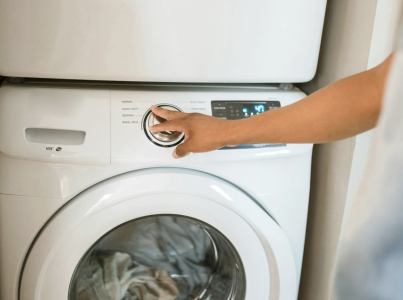A simple laundry change that could help cut household energy costs
By
Veronica E.
- Replies 0
When utility bills creep higher, many of us focus on the thermostat, windows, or appliances to find savings.
But one area that often goes unnoticed is the laundry room.
Washing machines and dryers may seem routine, yet the way you set them can quietly add hundreds of dollars to your yearly energy expenses.
Fortunately, with today’s detergents and machines, a small shift in your laundry routine can make a noticeable difference.
By choosing the right water temperature, you can save money, protect your clothes, and even reduce your household’s environmental impact—all without compromising cleanliness.

In past decades, hot water was considered the standard for truly clean laundry.
Older detergents required heat to dissolve properly, and many people trusted high temperatures to kill germs.
But experts say modern machines and detergents work differently.
Corey Gilgan, a home energy specialist, explains: “Most people don’t realize their water heater is the real energy hog in this equation. When you select hot water, you’re essentially asking your water heater to work at maximum capacity for 30–45 minutes per load.”
That demand can raise a washing machine’s energy use by as much as 90%.
Over the course of a year, the cost difference can be as high as $200.
Energy experts now recommend setting your wash temperature between 60 and 80 degrees Fahrenheit.
This range is often labeled as “cold” or “cool” on most washers.
It’s effective for everyday laundry—shirts, delicates, darks, and lightly soiled clothing.
Modern detergents are specially formulated with enzymes that activate at lower temperatures.
In fact, washing with hot water can sometimes reduce effectiveness by breaking down enzymes before they get to work.
Cold water is ideal for most loads, but there are exceptions.
Heavily soiled clothing, items exposed to germs, or certain synthetic fabrics may require warmer water—typically in the 90 to 110 degree Fahrenheit range.
Reserving hot washes for these cases ensures you still get the deep cleaning you need while saving energy the rest of the time.
A recent PowerLines survey highlights why small savings matter:
Despite these concerns, 60% of respondents admitted they don’t know who actually sets their local utility rates.
That makes small, practical changes at home—like adjusting laundry habits—even more valuable.
Laundry isn’t the only place to look for efficiency:
The next time you do laundry, remember that you don’t need piping hot water to get clothes fresh and clean.
Machines and detergents are designed for cooler settings, helping you save money and extend the life of your clothing.
Small changes like this add up, creating benefits for your wallet, your home, and the environment.
Read next:

Have you already switched to cooler washes? If so, have you noticed savings—or maybe just fresher, longer-lasting clothes? Let us know the comments in the below!
But one area that often goes unnoticed is the laundry room.
Washing machines and dryers may seem routine, yet the way you set them can quietly add hundreds of dollars to your yearly energy expenses.
Fortunately, with today’s detergents and machines, a small shift in your laundry routine can make a noticeable difference.
By choosing the right water temperature, you can save money, protect your clothes, and even reduce your household’s environmental impact—all without compromising cleanliness.

Small changes at home can add up to meaningful savings over time. Image Source: Pexels / RDNE Stock project.
Hot water: once essential, now outdated
In past decades, hot water was considered the standard for truly clean laundry.
Older detergents required heat to dissolve properly, and many people trusted high temperatures to kill germs.
But experts say modern machines and detergents work differently.
Corey Gilgan, a home energy specialist, explains: “Most people don’t realize their water heater is the real energy hog in this equation. When you select hot water, you’re essentially asking your water heater to work at maximum capacity for 30–45 minutes per load.”
That demand can raise a washing machine’s energy use by as much as 90%.
Over the course of a year, the cost difference can be as high as $200.
Also read: Cut $128.52 off your energy bill! Try this simple trick
Why cool water is best for most loads
Energy experts now recommend setting your wash temperature between 60 and 80 degrees Fahrenheit.
This range is often labeled as “cold” or “cool” on most washers.
It’s effective for everyday laundry—shirts, delicates, darks, and lightly soiled clothing.
Modern detergents are specially formulated with enzymes that activate at lower temperatures.
In fact, washing with hot water can sometimes reduce effectiveness by breaking down enzymes before they get to work.
Added benefits of cool washes:
- Clothes last longer. Cold water helps prevent colors from fading and fabrics from shrinking.
- Lower environmental impact. Reducing hot water use lowers your household’s carbon footprint.
- Household savings. The extra $200 per year can be redirected to more enjoyable expenses.
Also read: This simple trick could slash your energy bill by $38 every month—Find out how!
When hot water is still useful
Cold water is ideal for most loads, but there are exceptions.
Heavily soiled clothing, items exposed to germs, or certain synthetic fabrics may require warmer water—typically in the 90 to 110 degree Fahrenheit range.
Reserving hot washes for these cases ensures you still get the deep cleaning you need while saving energy the rest of the time.
Also read: 5 things that drain the most electricity in your home
The bigger picture: energy bills on the rise
A recent PowerLines survey highlights why small savings matter:
- 64% of Americans say their utility bills have risen in the past year.
- 63% report higher bills are adding financial stress.
- Nearly half view rising utility costs as a broader sign of economic strain.
Despite these concerns, 60% of respondents admitted they don’t know who actually sets their local utility rates.
That makes small, practical changes at home—like adjusting laundry habits—even more valuable.
Also read: Cut $235 off your energy bills with these 6 simple tricks—plus, the “layering” hack that saves $140 instantly!
Additional ways to save at home
Laundry isn’t the only place to look for efficiency:
- Unplug unused electronics. Chargers, coffee makers, and standby devices can waste as much as $300 a year in electricity.
- Check assistance programs. Some states provide households with energy aid of up to $2,400 to help cover utility bills.
- Maintain appliances. Cleaning dryer vents, sealing leaks, and upgrading old machines can prevent waste.
The next time you do laundry, remember that you don’t need piping hot water to get clothes fresh and clean.
Machines and detergents are designed for cooler settings, helping you save money and extend the life of your clothing.
Small changes like this add up, creating benefits for your wallet, your home, and the environment.
Read next:
- This 92-year-old woman overpaid energy bills for a decade—don’t let this shocking mistake happen to you
- How one thermostat setting can lower bills and stop mold in its tracks
- Make your retirement money last—15 genius, practical ways to cut costs and enjoy life more
Key Takeaways
- Heating water is the biggest energy drain in laundry, and switching to cold or cool water can save around $200 annually.
- Today’s detergents are made to work best in cooler temperatures, making hot water unnecessary for most loads.
- Cold washes also help fabrics last longer by preventing shrinkage and fading, while lowering environmental impact.
- Using hot water only for heavily soiled clothing or special fabrics ensures cleanliness without wasting energy.
Have you already switched to cooler washes? If so, have you noticed savings—or maybe just fresher, longer-lasting clothes? Let us know the comments in the below!






